Remote Sensing Study on the Coupling Relationship between Regional Ecological Environment and Human Activities: A Case Study of Qilian Mountain National Nature Reserve
Abstract
1. Introduction
2. Materials and Methods
2.1. Study Area
2.2. Data Sources
2.3. Methods
2.3.1. Summary of Research Method
2.3.2. Calculation Method of Ecological Evaluation Sub-Index
- 1.
- Habitat quality sub-index
- 2.
- Landscape pattern sub-index
- 3.
- Ecological services sub-index.
2.3.3. Evaluation of Comprehensive Ecological Index
2.3.4. Coupling of Ecological Index and Human Activity Index
- Integrating MK test and correlation analysis
- 2.
- Analysis of coupling degree and ecological spatial accessibility
3. Results
3.1. Comprehensive Ecological Status Analysis
3.2. Coupling Analysis of Ecological Status and Human Activities
3.2.1. Analysis of Temporal and Spatial Correlation between Ecological Indicators and Human Activities
3.2.2. Human Activity-Ecological Environment Coupling State Classification Based on MK Test and Correlation Analysis
3.2.3. Evaluation of Services Provided by Ecological Environment to Human Beings
3.2.4. Analysis of Coupling Degree between Human Activity and Ecological Environment
3.2.5. Analysis of Coupling State between Human Activity and Ecological Environment Based on Various Analysis Results
4. Discussion
5. Conclusions
- 1.
- Evaluation of comprehensive ecological conditions
- 2.
- Correlation and spatial heterogeneity between human activities and the environment
- 3.
- Human–environment coupling evaluation based on MK test and correlation analysis
- 4.
- Comparison and fusion of coupling analysis and accessibility analysis
Author Contributions
Funding
Institutional Review Board Statement
Informed Consent Statement
Data Availability Statement
Acknowledgments
Conflicts of Interest
References
- Aslan, A.; Altinoz, B.; Ozsolak, B. The link between urbanization and air pollution in Turkey: Evidence from dynamic autoregressive distributed lag simulations. Environ. Sci. Pollut. Res. 2017, 28, 52370–52380. [Google Scholar] [CrossRef] [PubMed]
- Kolpin, D.; Furlong, E.; Meyer, M.; Thurman, E.; Zaugg, S.; Barber, L.; Buxton, H. Pharmaceuticals, hormones, and other organic wastewater contaminants in US streams, 1999–2000: A national reconnaissance. Environ. Sci. Technol. 2002, 36, 1202–1211. [Google Scholar] [CrossRef] [PubMed]
- Nriagu, J.O.; Pacyna, J.M. Quantitative assessment of worldwide contamination of air, water and soils by trace metals. Nature 1998, 333, 134–139. [Google Scholar] [CrossRef] [PubMed]
- Ni, J.L.; Cai, L.; Wang, J.K. Application Research on the Coupled Human-Environment Ecosystem Vulnerability Assessment in Different Spatial and Temporal Scales. Appl. Mech. Mater. 2014, 535, 255–265. [Google Scholar] [CrossRef]
- Gurney, K.R.; Romero-Lankao, P.; Seto, K.C.; Hutyra, L.R.; Duren, R.; Kennedy, C.; Grimm, N.B.; Ehleringer, J.R.; Marcotullio, P.; Hughes, S.; et al. Climate change track urban emissions on a human scale. Nature 2015, 525, 179–181. [Google Scholar] [CrossRef]
- Wang, S.; Fu, B.; Zhao, W.; Liu, Y.; Wei, F. Structure, function, and dynamic mechanisms of coupled human–natural systems. Curr. Opin. Environ. Sustain. 2018, 33, 87–91. [Google Scholar] [CrossRef]
- Koutsoyiannis, D.; Kundzewicz, Z.W. Atmospheric Temperature and CO2: Hen-Or-Egg Causality? Science 2020, 2, 83. [Google Scholar] [CrossRef]
- Coppin, P.; Jonckheere, I.; Nackaerts, K.; Muys, B.; Lambin, E. Digital change detection methods in ecosystem monitoring: A review. Int. J. Remote Sens. 2004, 25, 1565–1596. [Google Scholar] [CrossRef]
- Song, W.; Song, W.; Gu, H.; Li, F. Progress in the Remote Sensing Monitoring of the Ecological Environment in Mining Areas. Int. J. Environ. Res. Public Health 2020, 17, 1846. [Google Scholar] [CrossRef]
- Zhao, J.; Wang, J.; Hong, Q.; Song, Q.; Huang, L.; Zhang, D. Investigation of Natural Ecological Enviroment Using Remote Sensing Based Integrated Index at A City Scale. In Proceedings of the IGARSS 2018—2018 IEEE International Geoscience and Remote Sensing Symposium, Valencia, Spain, 22–27 July 2018; pp. 2467–2470. [Google Scholar]
- Liu, J.; Dietz, T.; Carpenter, S.R.; Folke, C.; Alberti, M.; Redman, C.L.; Schneider, S.H.; Ostrom, E.; Pell, A.N.; Lubchenco, J.; et al. Coupled human and natural systems. Ambio 2007, 36, 639–649. [Google Scholar] [CrossRef]
- Liu, H.; Fang, C.; Fang, K. Coupled Human and Natural Cube: A novel framework for analyzing the multiple interactions between humans and nature. J. Geogr. Sci. 2020, 30, 355–377. [Google Scholar] [CrossRef]
- Handfield, R.; Walton, S.V.; Sroufe, R.; Melnyk, S.A. Applying environmental criteria to supplier assessment: A study in the application of the Analytical Hierarchy Process. Eur. J. Oper. Res. 2002, 141, 70–87. [Google Scholar] [CrossRef]
- Wang, X.; Cao, Y.; Zhong, X.; Gao, P. A new method of regional eco-environmental quality assessment and its application. J. Environ. Qual. 2012, 41, 1393–1401. [Google Scholar] [CrossRef] [PubMed]
- Hu, X.; Xu, H. A new remote sensing index based on the pressure-state-response framework to assess regional ecological change. Env. Sci. Pollut. Res. Int. 2019, 26, 5381–5393. [Google Scholar] [CrossRef]
- Tian, X.; Ju, M.; Shao, C.; Fang, Z. Developing a new grey dynamic modeling system for evaluation of biology and pollution indicators of the marine environment in coastal areas. Ocean Coast. Manag. 2011, 54, 750–759. [Google Scholar] [CrossRef]
- Kosiba, P. Self-organizing feature maps and selected conventional numerical. Acta Soc. Bot. Pol. 2009, 78, 335–343. [Google Scholar] [CrossRef]
- Xu, H.; Wang, Y.; Guan, H.; Shi, T.; Hu, X. Detecting Ecological Changes with a Remote Sensing Based Ecological Index (RSEI) Produced Time Series and Change Vector Analysis. Remote Sens. 2019, 11, 2345. [Google Scholar] [CrossRef]
- Liu, W.; Chen, G. Evolution of Ecosystem Service Value and Ecological Storage Estimation in Huainan Coal Mining Area. Bull. Env. Contam. Toxicol. 2021, 107, 1243–1249. [Google Scholar] [CrossRef]
- Liu, Y.; Li, J.; Xia, J.; Hao, G.; Teo, F. Risk assessment of non-point source pollution based on landscape pattern in the Hanjiang River basin, China. Env. Sci. Pollut. Res. Int. 2021, 28, 64322–64336. [Google Scholar] [CrossRef]
- Costanza, R.; d’Arge, R.; Groot, R.d.; Farber, S.; Grasso, M.; Hannon, B.; Limburg, K.; Naeem, S.; O’Neill, R.V.; Paruelo, J.; et al. The value of the world’s ecosystem services and natural capital. Nature 1997, 387, 253–260. [Google Scholar] [CrossRef]
- Hu, X.; Xu, H. A new remote sensing index for assessing the spatial heterogeneity in urban ecological quality: A case from Fuzhou City, China. Ecol. Indic. 2018, 89, 11–21. [Google Scholar] [CrossRef]
- Sanze, F.; Huimin, Z.; Hui, S.; Jianchun, W.; Lijun, R. Examination of a coupling coordination relationship between urbanization and the eco-environment: A case study in Qingdao, China. Env. Sci. Pollut. Res. Int. 2020, 27, 23981–23993. [Google Scholar] [CrossRef]
- Huang, M.; Li, Y.; Xia, C.; Zeng, C.; Zhang, B. Coupling responses of landscape pattern to human activity and their drivers in the hinterland of Three Gorges Reservoir Area. Glob. Ecol. Conserv. 2022, 33, e01992. [Google Scholar] [CrossRef]
- Zhang, X.; Xu, Z. Functional Coupling Degree and Human Activity Intensity of Production–Living–Ecological Space in Underdeveloped Regions in China: Case Study of Guizhou Province. Land 2021, 10, 56. [Google Scholar] [CrossRef]
- Chai, L.H.; Lha, D. A new approach of deriving indicators and comprehensive measure for ecological environmental quality assessment. Ecol. Indic. 2018, 85, 716–728. [Google Scholar] [CrossRef]
- Ji, Z.; Yingjie, H.; Boldanov, T.; Bazarzhapov, T.; Dan, M.; Li, Y.; Dong, S. Comprehensive assessment of the coupling coordination degree between urbanization and ecological environment in the Siberian and Far East Federal Districts, Russia from 2005 to 2017. PeerJ 2020, 8, e9125. [Google Scholar] [CrossRef]
- Liu, J.; Dietz, T.; Carpenter, S.R.; Albert, M.; Folk, C.; Moran, E.; Pell, A.N.; Deadman, P.; Kratz, T.; Lubchenc, J.; et al. Complexity of coupled human and natural systems. Science 2007, 317, 1513–1516. [Google Scholar] [CrossRef]
- Ostrom, E. A general framework for analyzing sustainability of social-ecological systems. Science 2009, 325, 419–422. [Google Scholar] [CrossRef]
- Liu, J.; Hull, V.; Godfray, H.C.J.; Tilman, D.; Gleick, P.; Hoff, H.; Pahl-Wostl, C.; Xu, Z.; Chung, M.G.; Sun, J.; et al. Nexus approaches to global sustainable development. Nat. Sustain. 2018, 1, 466–476. [Google Scholar] [CrossRef]
- Holling, C. Understanding the Complexity of Economic, Ecological, and Social Systems. Ecosystems 2001, 4, 390–405. [Google Scholar] [CrossRef]
- Firozjaei, M.K.; Fathololoumi, S.; Weng, Q.; Kiavarz, M.; Alavipanah, S.K. Remotely Sensed Urban Surface Ecological Index (RSUSEI): An Analytical Framework for Assessing the Surface Ecological Status in Urban Environments. Remote Sens. 2020, 12, 2029. [Google Scholar] [CrossRef]
- Ma, H.; Shi, L. Assessment of eco-environmental quality of Western Taiwan Straits Economic Zone. Environ. Monit. Assess. 2016, 188, 311–321. [Google Scholar] [CrossRef] [PubMed]
- Reza, M.I.H.; Abdullah, S.A. Regional Index of Ecological Integrity: A need for sustainable management of natural resources. Ecol. Indic. 2011, 11, 220–229. [Google Scholar] [CrossRef]
- Wei, W.; Guo, Z.; Xie, B.; Zhou, J.; Li, C. Spatiotemporal evolution of environment based on integrated remote sensing indexes in arid inland river basin in Northwest China. Env. Sci. Pollut. Res. Int. 2019, 26, 13062–13084. [Google Scholar] [CrossRef] [PubMed]
- Xu, H.; Wang, M.; Shi, T.; Guan, H.; Fang, C.; Lin, Z. Prediction of ecological effects of potential population and impervious surface increases using a remote sensing based ecological index (RSEI). Ecol. Indic. 2018, 93, 730–740. [Google Scholar] [CrossRef]
- Boumans, R.; Roman, J.; Altman, I.; Kaufman, L. The Multiscale Integrated Model of Ecosystem Services (MIMES): Simulating the interactions of coupled human and natural systems. Ecosyst. Serv. 2015, 12, 30–41. [Google Scholar] [CrossRef]
- Yan, K.; Ding, Y. The overview of the progress of Qilian Mountain National Park System Pilot Area. Int. J. Geoheritage Parks 2020, 8, 210–214. [Google Scholar] [CrossRef]
- Zhang, Q.; Schaaf, C.; Seto, K.C. The Vegetation Adjusted NTL Urban Index: A new approach to reduce saturation and increase variation in nighttime luminosity. Remote Sens. Environ. 2013, 129, 32–41. [Google Scholar] [CrossRef]
- Luo, W. Using a GIS-based floating catchment method to assess areas with shortage of physicians. Health Place 2004, 10, 1–11. [Google Scholar] [CrossRef]
- Sun, H.; Wu, L.; Hu, J.; Ma, L.; Li, H.; Wu, D. Evaluating eco-environment in urban agglomeration from a vegetation-impervious surface-soil-air framework: An example in Ningxia, China. J. Appl. Remote Sens. 2021, 15, 014518. [Google Scholar] [CrossRef]
- Jimenez-Munoz, J.C.; Sobrino, J.A.; Skokovic, D.; Mattar, C.; Cristobal, J. Land Surface Temperature Retrieval Methods From Landsat-8 Thermal Infrared Sensor Data. IEEE Geosci. Remote Sens. Lett. 2014, 11, 1840–1843. [Google Scholar] [CrossRef]
- Peng, J.; Wang, Y.; Zhang, Y.; Wu, J.; Li, W.; Li, Y. Evaluating the effectiveness of landscape metrics in quantifying spatial patterns. Ecol. Indic. 2010, 10, 217–223. [Google Scholar] [CrossRef]
- He, H.S.; DeZonia, B.E.; Mladenoff, D.J. An aggregation index (AI) to quantify spatial patterns of landscapes. Landsc. Ecol. 2000, 15, 591–601. [Google Scholar] [CrossRef]
- Yue, S.; Pilon, P.; Cavadias, G. Power of the Mann-Kendall and Spearman’s rho tests for detecting monotonic trends in hydrological series. J. Hydrol. 2002, 259, 254–271. [Google Scholar] [CrossRef]
- Koo, T.K.; Li, M.Y. A Guideline of Selecting and Reporting Intraclass Correlation Coefficients for Reliability Research. J. Chiropr. Med. 2016, 15, 155–163. [Google Scholar] [CrossRef] [PubMed]
- Nelson, E.; Mendoza, G.; Regetz, J.; Polasky, S.; Tallis, H.; Cameron, D.; Chan, K.M.A.; Daily, G.C.; Goldstein, J.; Kareiva, P.M.; et al. Modeling multiple ecosystem services, biodiversity conservation, commodity production, and tradeoffs at landscape scales. Front. Ecol. Environ. 2009, 7, 4–11. [Google Scholar] [CrossRef]
- Abdullah, S.; Adnan, M.S.G.; Barua, D.; Murshed, M.M.; Kabir, Z.; Chowdhury, M.B.H.; Hassan, Q.K.; Dewan, A. Urban green and blue space changes: A spatiotemporal evaluation of impacts on ecosystem service value in Bangladesh. Ecol. Inform. 2022, 70, 101730. [Google Scholar] [CrossRef]
- Song, Y.; Wang, J.; Ge, Y.; Xu, C. An optimal parameters-based geographical detector model enhances geographic characteristics of explanatory variables for spatial heterogeneity analysis: Cases with different types of spatial data. GISci. Remote Sens. 2020, 57, 593–610. [Google Scholar] [CrossRef]
- Xue, J.; Li, Z.; Feng, Q.; Li, Z.; Gui, J.; Li, Y. Ecological conservation pattern based on ecosystem services in the Qilian Mountains, northwest China. Environ. Dev. 2023, 46, 100834. [Google Scholar] [CrossRef]
- Liu, Y.; Liu, X.; Zhao, C.; Wang, H.; Zang, F. The trade-offs and synergies of the ecological-production-living functions of grassland in the Qilian mountains by ecological priority. J. Environ. Manag. 2023, 327, 116883. [Google Scholar] [CrossRef]
- Shan, S.Y.; Xu, H.J.; Qi, X.L.; Chen, T.; Wang, X.D. Evaluation and prediction of ecological carrying capacity in the Qilian Mountain National Park, China. J. Env. Manag. 2023, 339, 117856. [Google Scholar] [CrossRef] [PubMed]
- Wang, H.; Liu, C.; Zang, F.; Liu, Y.; Chang, Y.; Huang, G.; Fu, G.; Zhao, C.; Liu, X. Remote Sensing-Based Approach for the Assessing of Ecological Environmental Quality Variations Using Google Earth Engine: A Case Study in the Qilian Mountains, Northwest China. Remote Sens. 2023, 15, 960. [Google Scholar] [CrossRef]
- Wang, Y.; Zhao, R.; Li, Y.; Yao, R.; Wu, R.; Li, W. Research on the evolution and the driving forces of land use classification for production, living, and ecological space in China’s Qilian Mountains Nature Reserve from 2000 to 2020. Env. Sci. Pollut. Res. Int. 2023, 30, 64949–64970. [Google Scholar] [CrossRef] [PubMed]
- Peng, Q.; Wang, R.; Jiang, Y.; Li, C. Contributions of climate change and human activities to vegetation dynamics in Qilian Mountain National Park, northwest China. Glob. Ecol. Conserv. 2021, 32, e01947. [Google Scholar] [CrossRef]
- Zongxing, L.; Qi, F.; Zongjie, L.; Xufeng, W.; Juan, G.; Baijuan, Z.; Yuchen, L.; Xiaohong, D.; Jian, X.; Wende, G.; et al. Reversing conflict between humans and the environment—The experience in the Qilian Mountains. Renew. Sustain. Energy Rev. 2021, 148, 111333. [Google Scholar] [CrossRef]
- Mu, H.; Li, X.; Ma, H.; Du, X.; Huang, J.; Su, W.; Yu, Z.; Xu, C.; Liu, H.; Yin, D.; et al. Evaluation of the policy-driven ecological network in the Three-North Shelterbelt region of China. Landsc. Urban Plan. 2022, 218, 104305. [Google Scholar] [CrossRef]
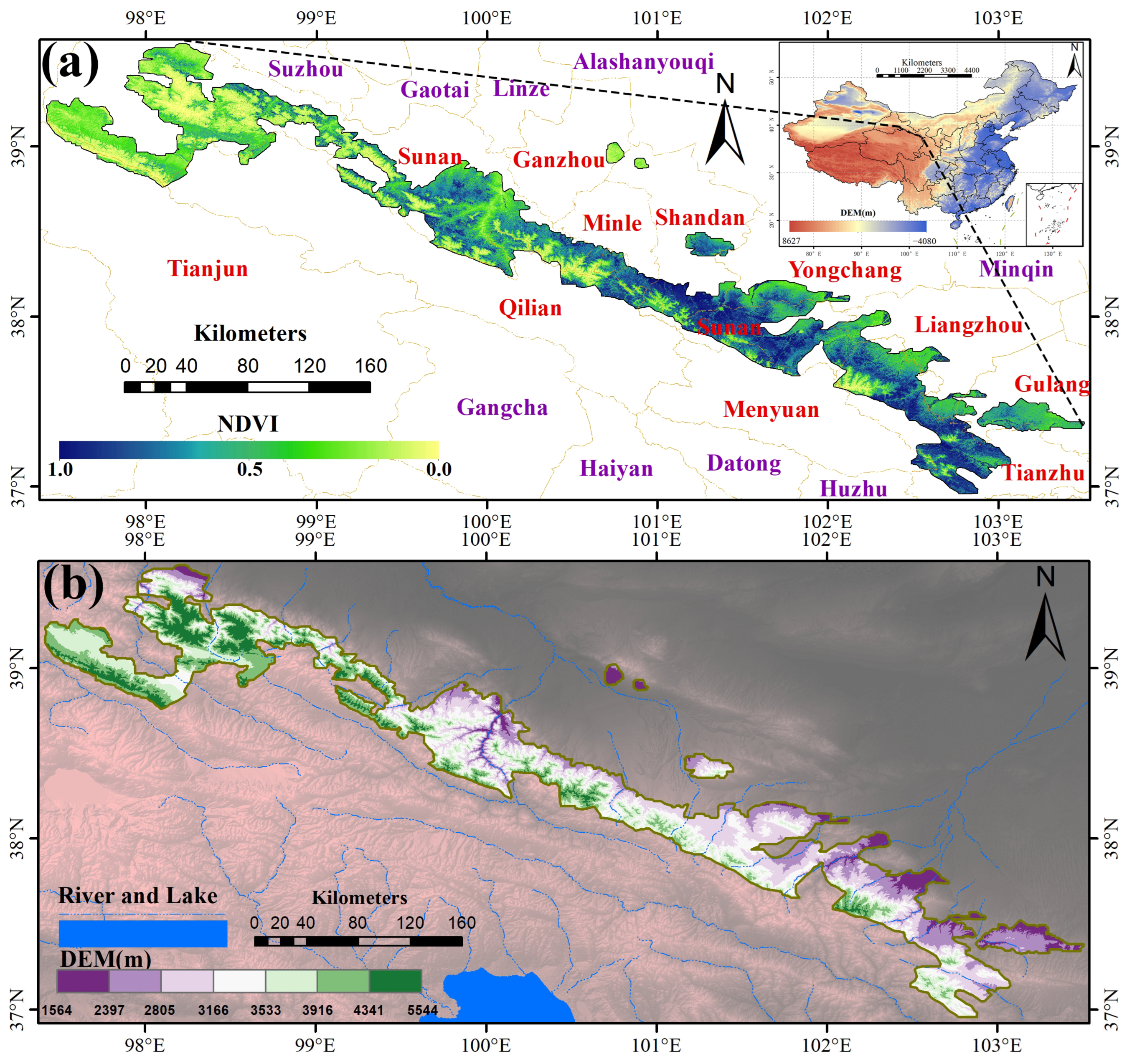
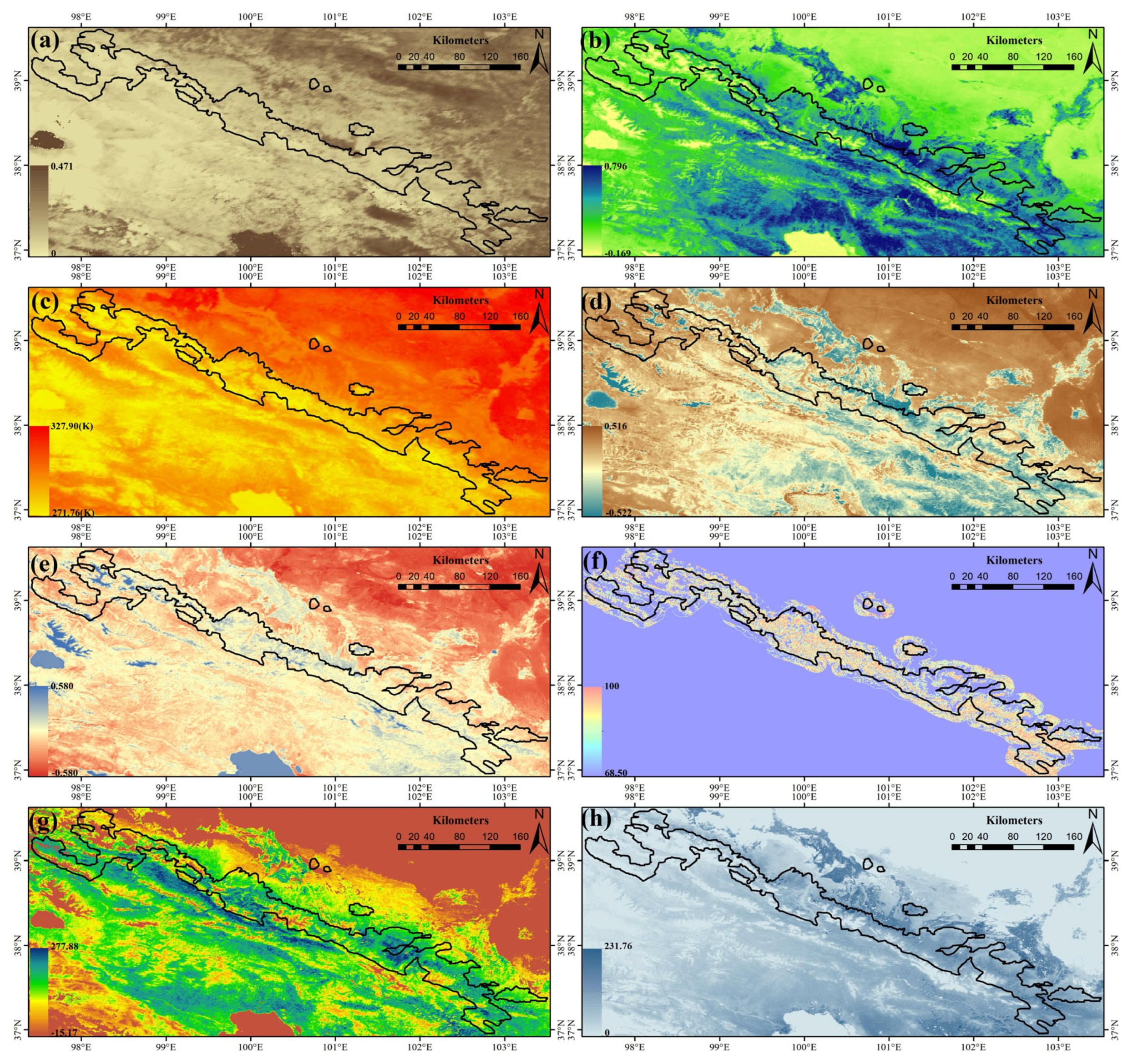
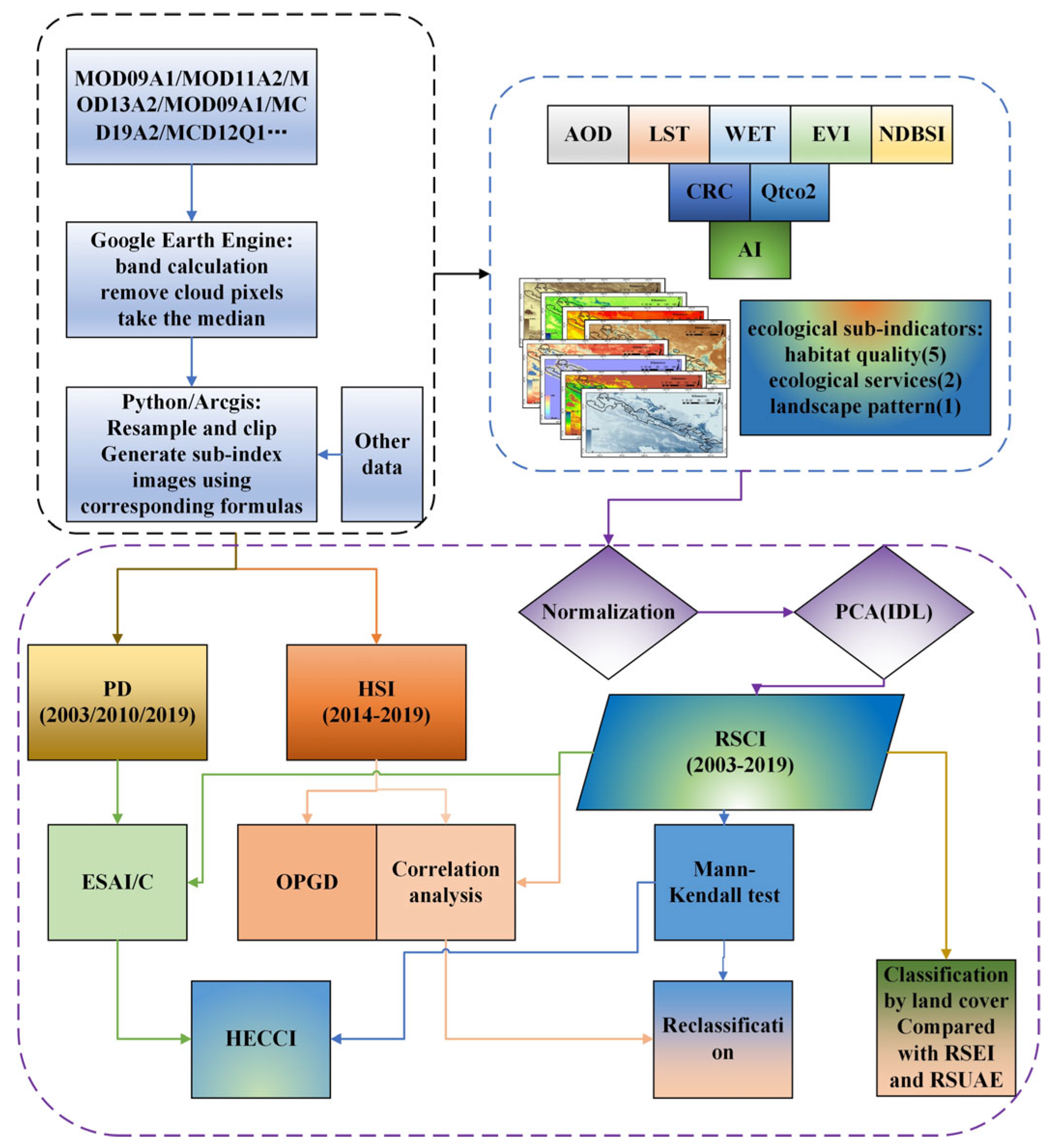
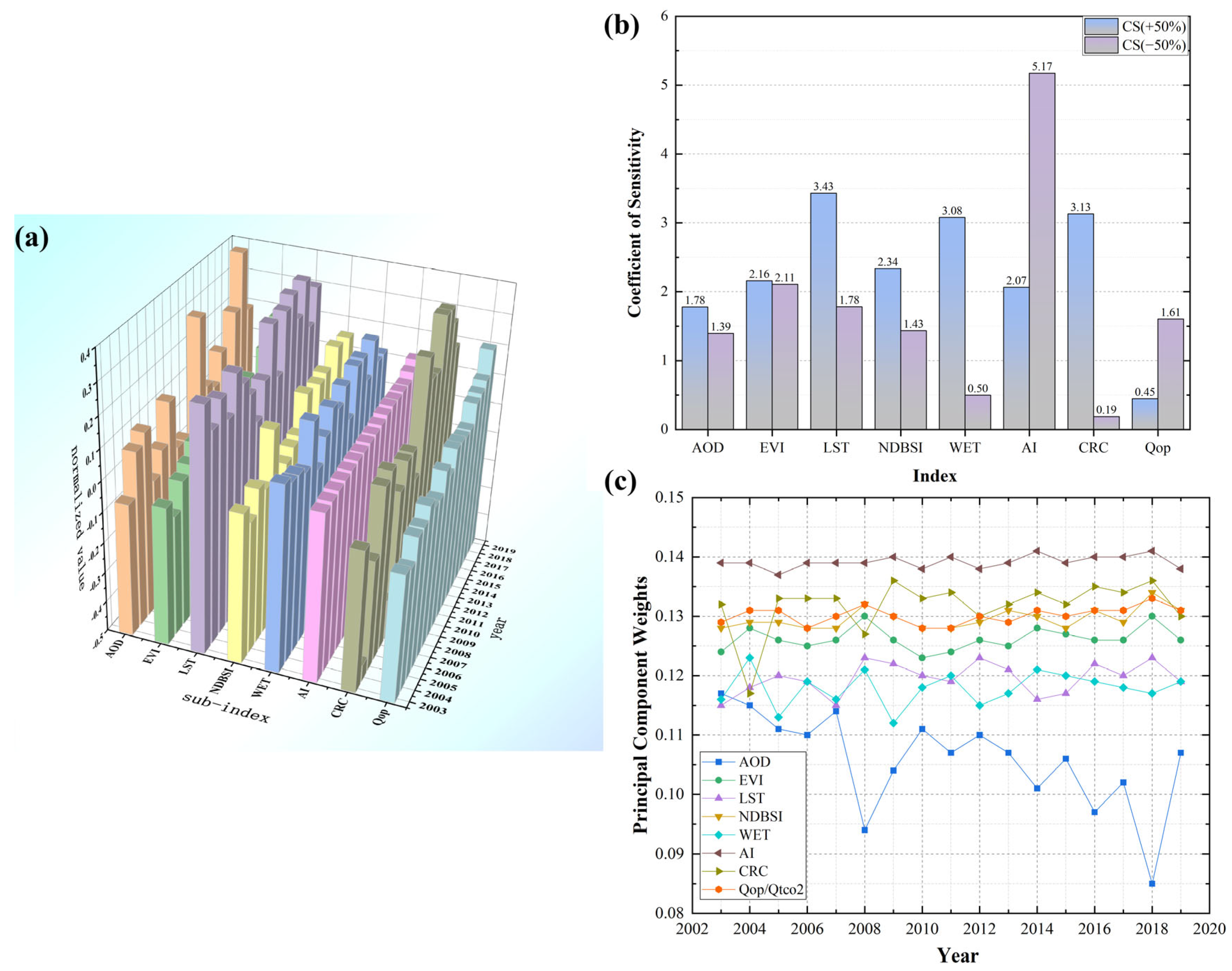
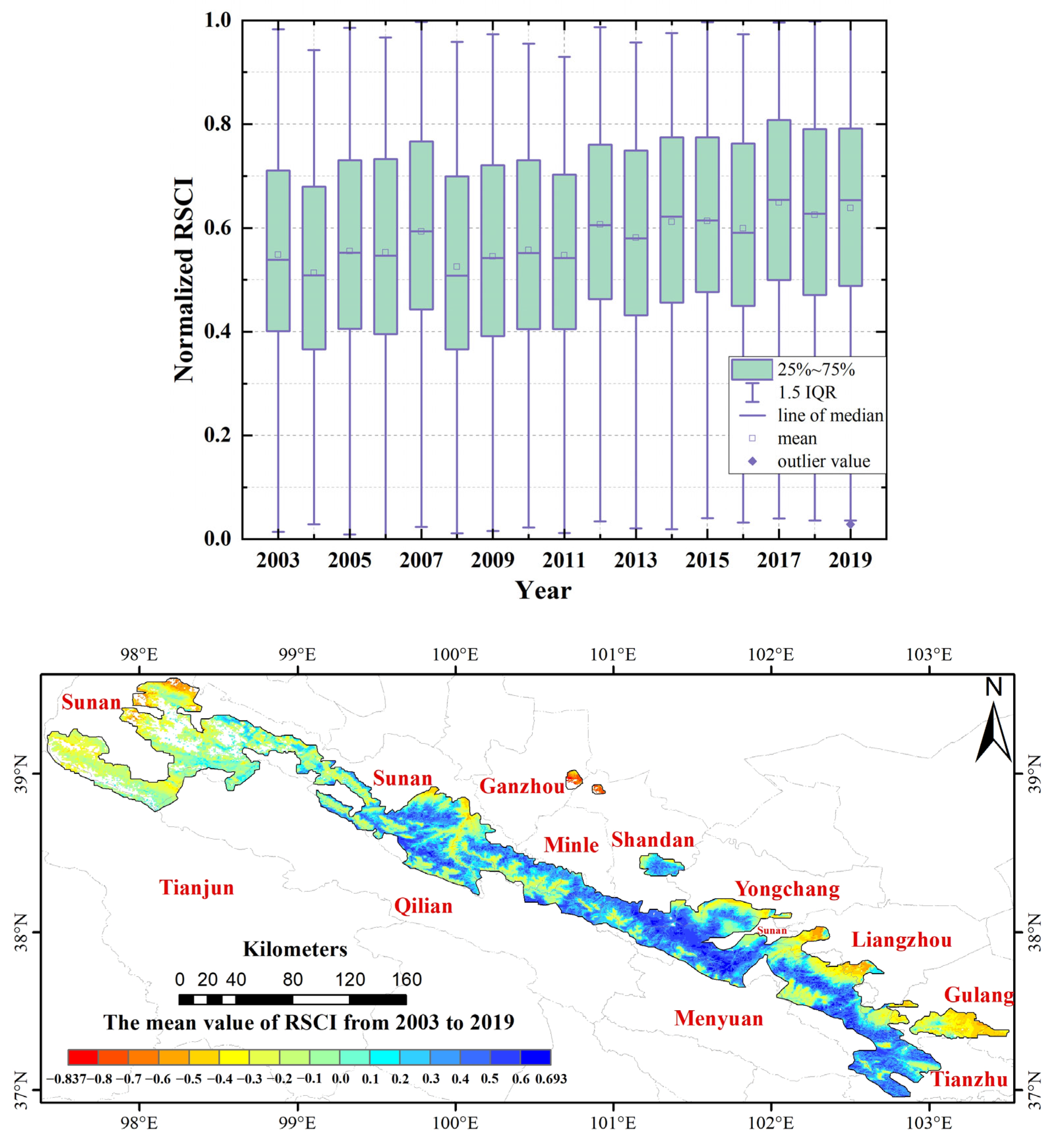

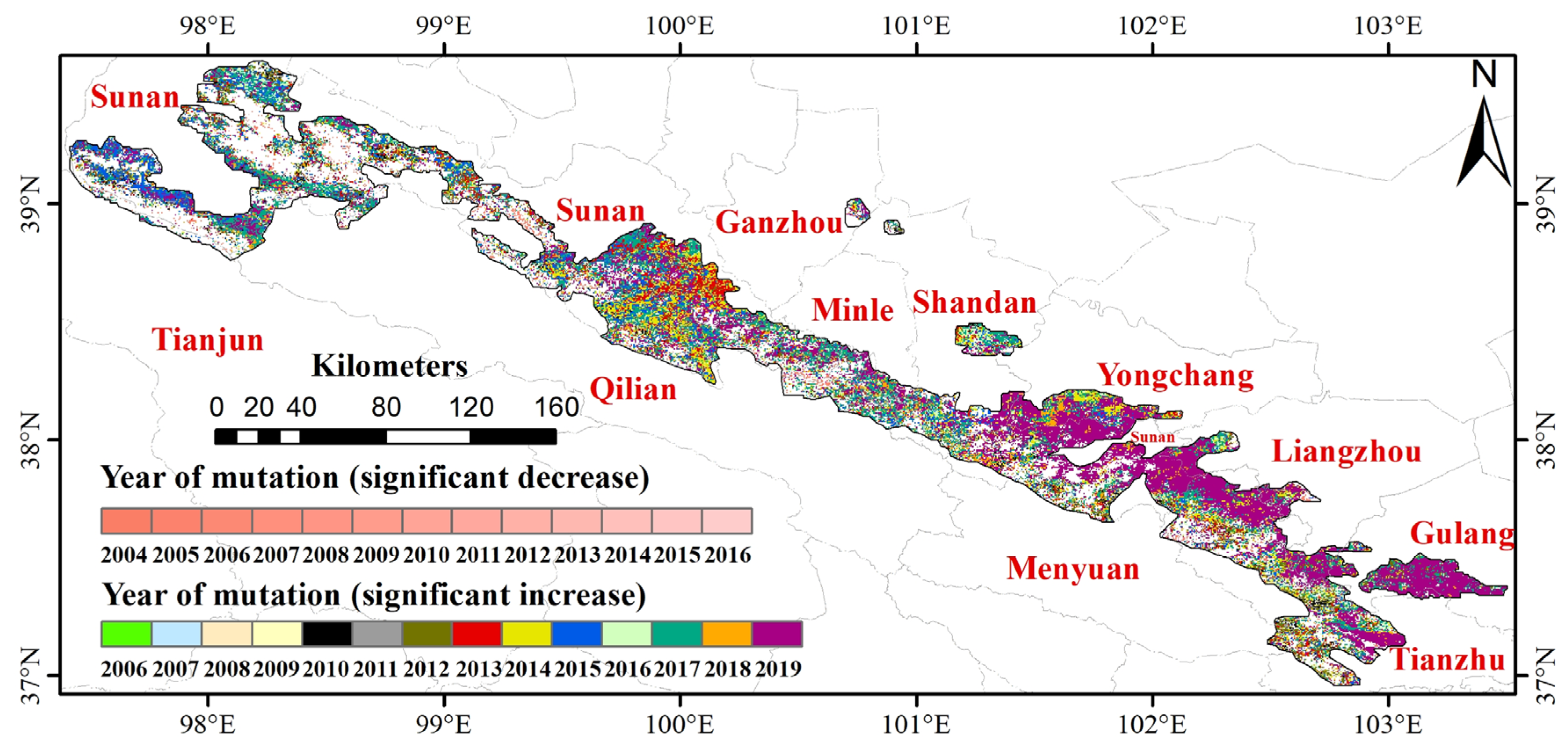
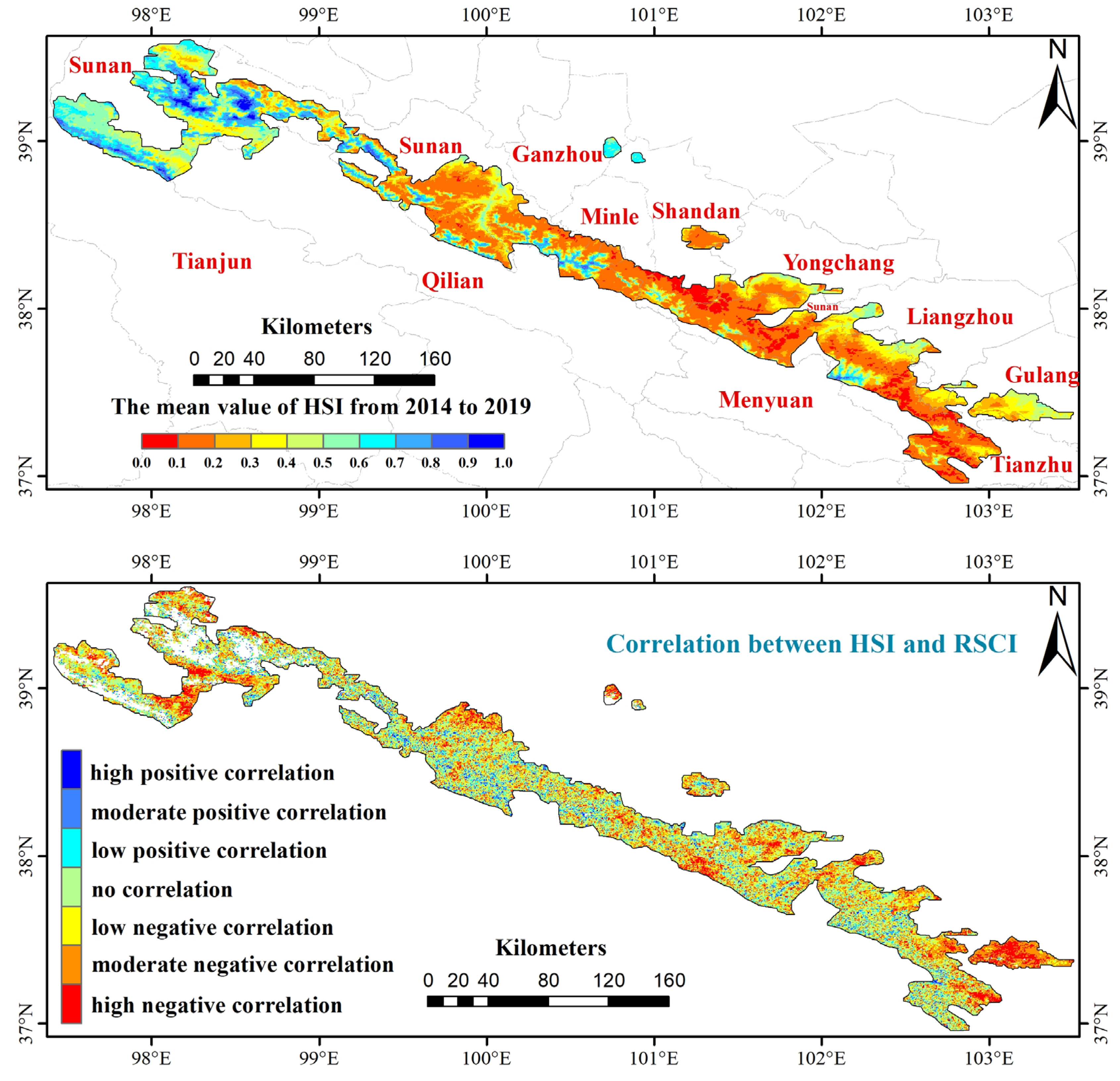

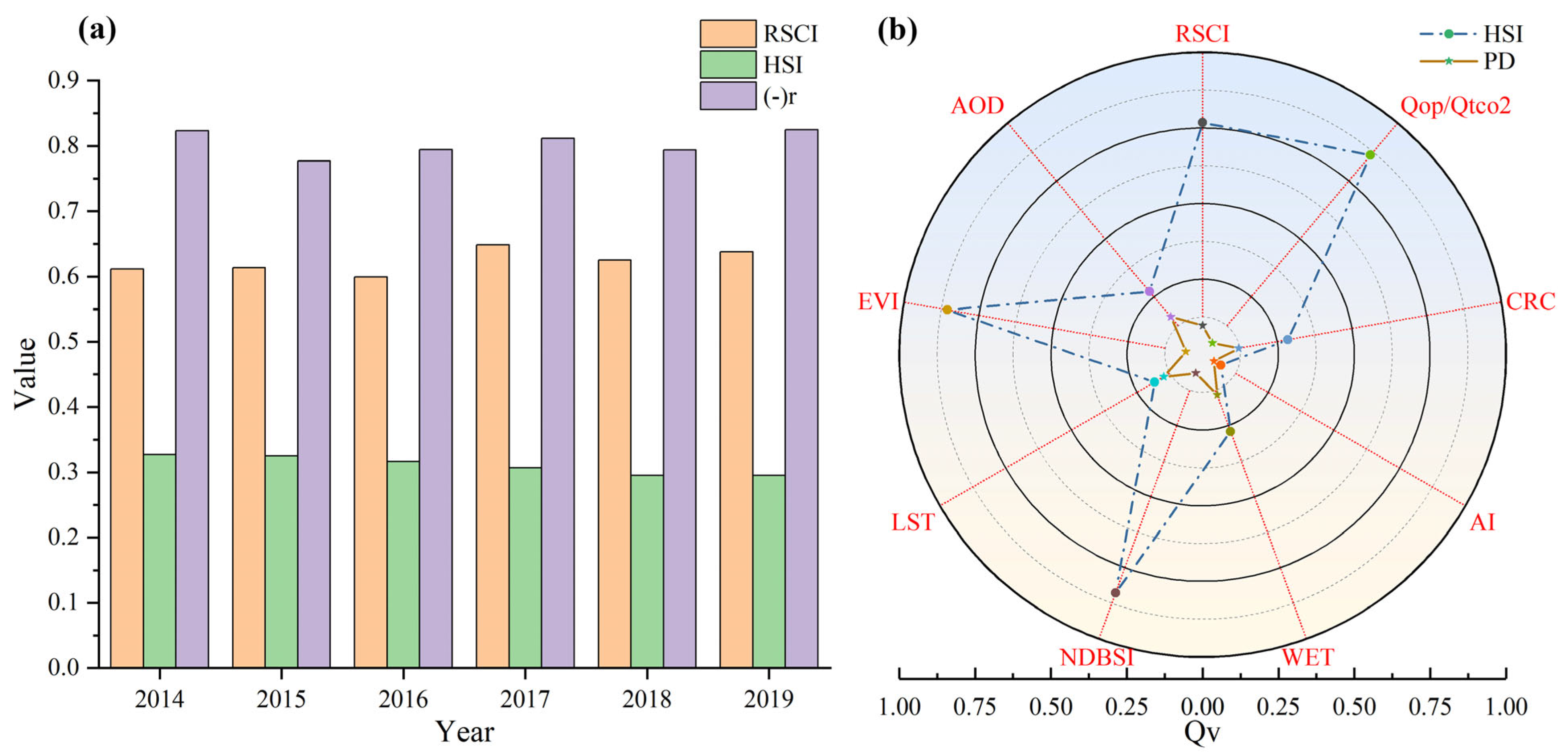
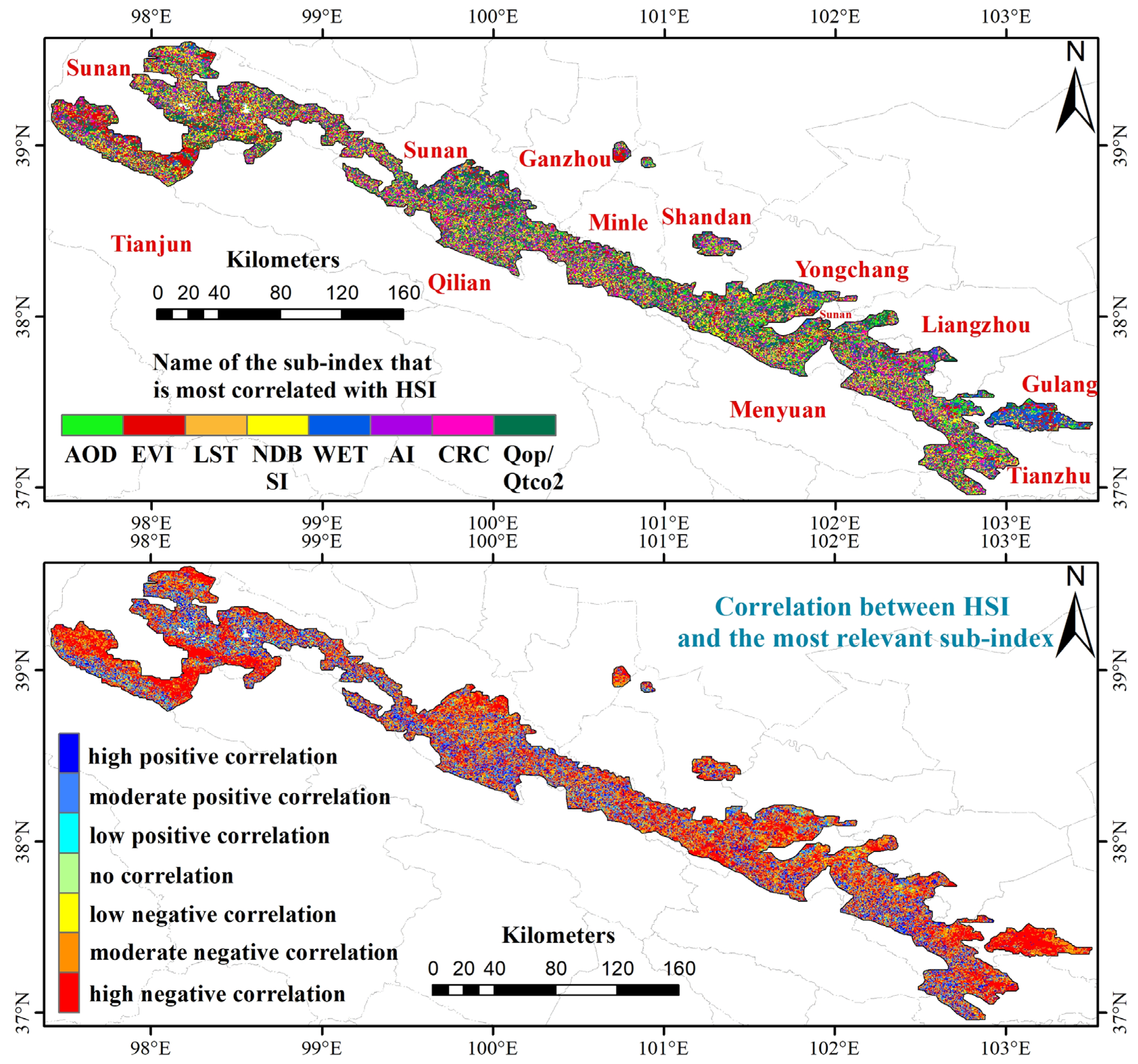
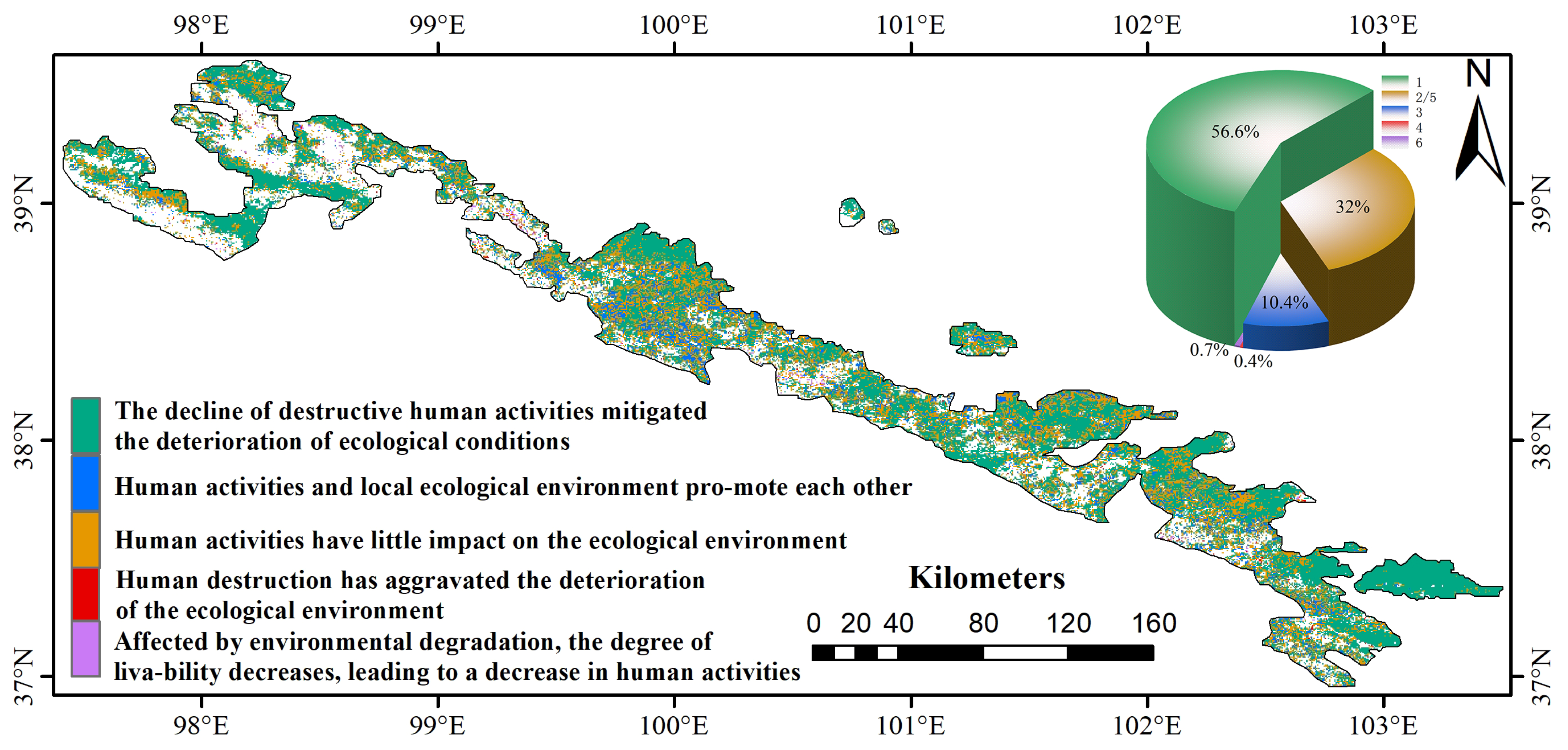
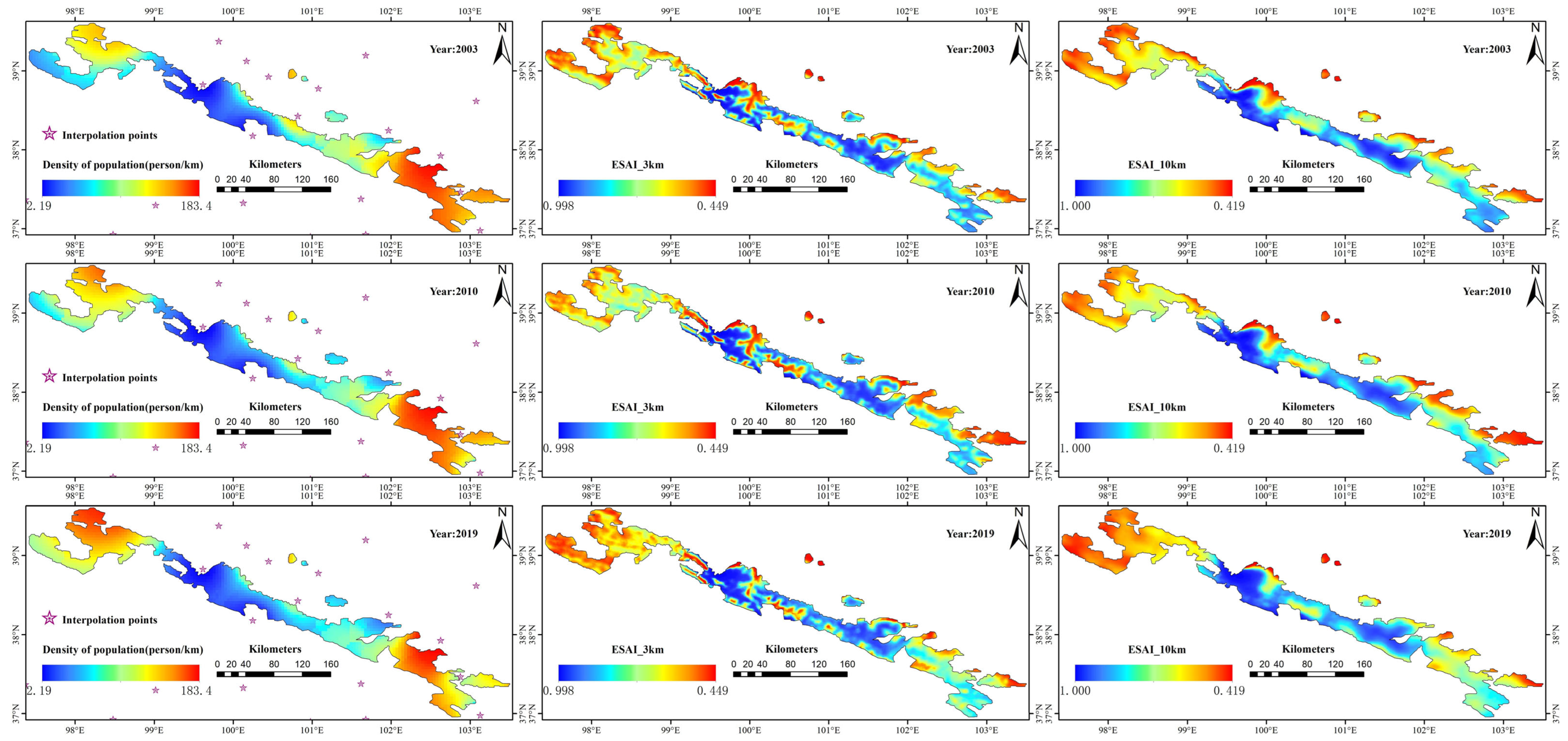

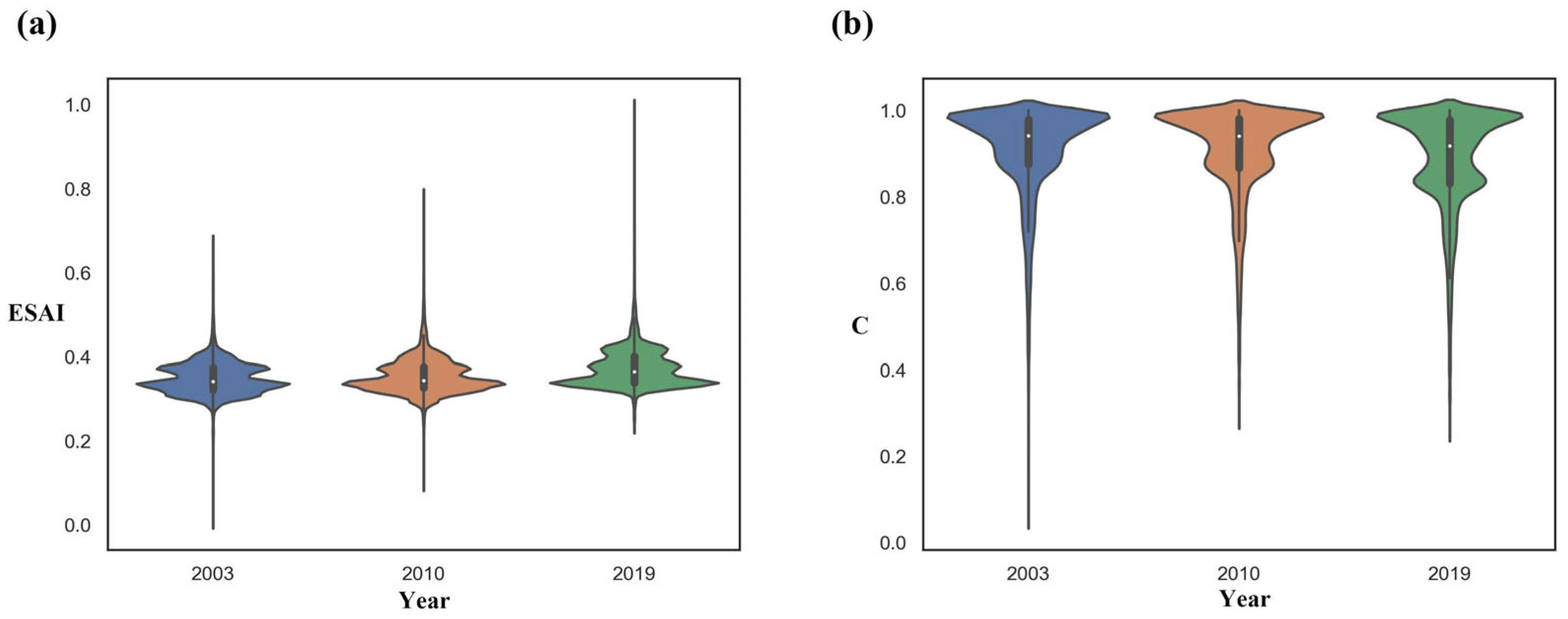
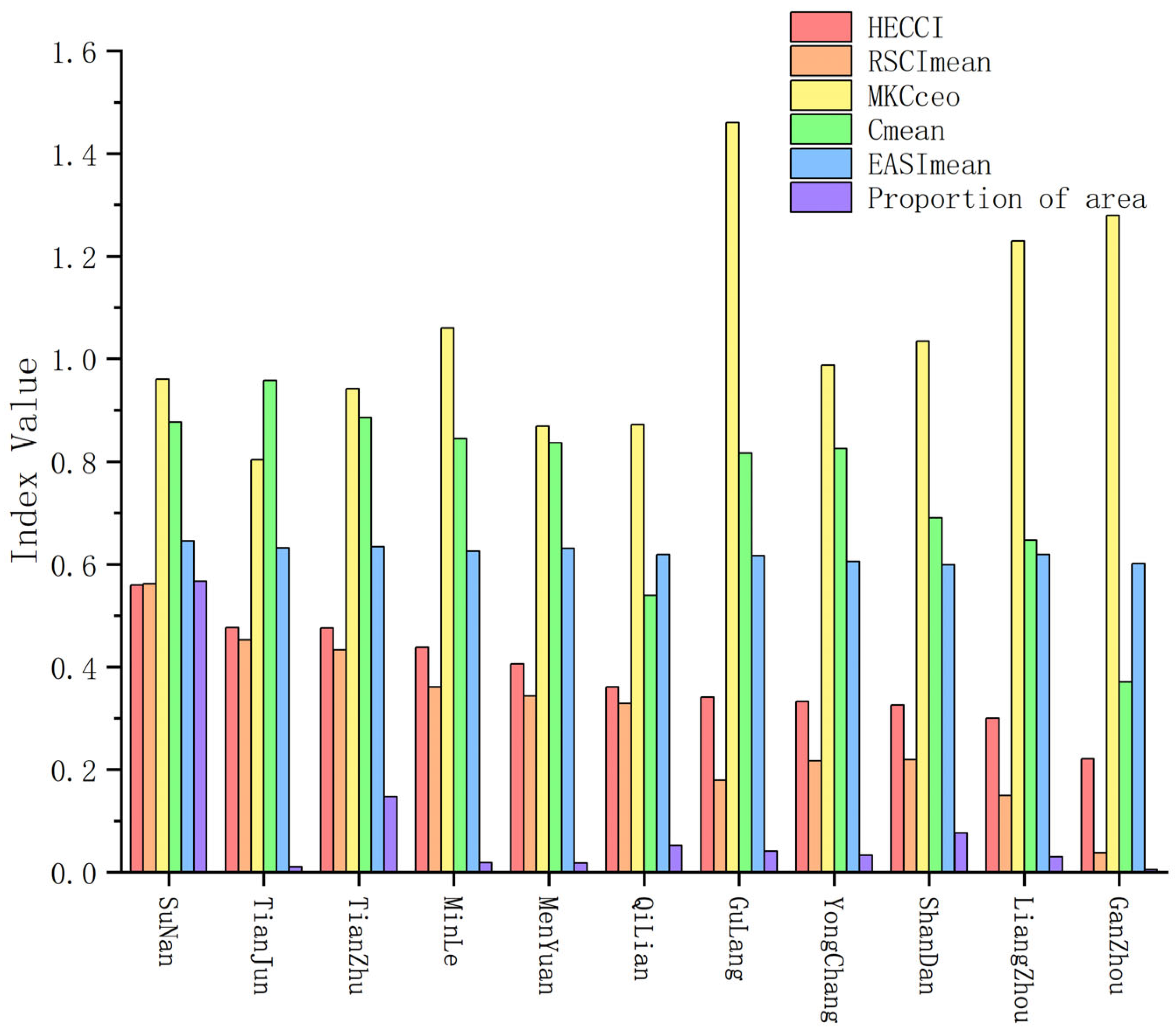

| Data Name (E/C) | Data Source | Resolution | Time Range |
|---|---|---|---|
| NDBSI (C) | MOD09A1.006:Terra Surface Reflectance 8-Day Global 500 m | 500 m/8-day | 2003–2019 |
| LST (E) | MOD11A2.006:Terra Land Surface Temperature and Emissivity 8-Day Global 1 km | 1000 m/8-day | 2003–2019 |
| AOD (E) | MCD19A2.006:Terra and Aqua MAIAC Land Aerosol Optical Depth Daily 1 km | 1000 m/1-day | 2003–2019 |
| EVI (E) | MOD13A2.006:Terra Vegetation Indexes 16-Day Global 1 km | 1000 m/16-day | 2003–2019 |
| WET (C) | MOD09A1.006:Terra Surface Reflectance 8-Day Global 500 m | 500 m/8-day | 2003–2019 |
| LC (E) | MCD12Q1.006:MODIS Land Cover Type Yearly Global 500 m | 500 m/1-year | 2003–2019 |
| AI (C) | Annual China Land Cover Dataset (CLCD) | 30 m/1-year | 2003–2019 |
| Qtco2/Qop (C) | MOD17A3HGF.006:Terra Net Primary Production Gap-Filled Yearly Global 500 m | 500 m/8-day | 2003–2019 |
| ET (E) | MOD16A2.006:Terra Net Evapotranspiration 8-Day Global 500 m | 500 m/8-day | 2003–2019 |
| Fpar (E) | MCD15A3H.006:MODIS Leaf Area Index/FPAR 4-Day Global 500 m | 500 m/4-day | 2003–2019 |
| Qsor (E) | RADI_MUL_CHN_DAY | meteorological station/1-day | 2003–2019 |
| NDVI (E) | MOD13A1.006:Terra Vegetation Indexes 16-Day Global 500 m | 500 m/16-day | 2014–2019 |
| NTL (E) | VIIRS Stray Light Corrected Nighttime Day/Night Band Composites Version 1 | 15 arc seconds/1-month | 2014–2019 |
| Population Density (E) | demographic census | 500 m | 2003, 2010, 2019 |
| Year of Mutation (Significant Decrease) | Number of Pixels | Year of Mutation (Significant Increase) | Number of Pixels |
|---|---|---|---|
| 2004 | 531 | 2019 | 18,738 |
| 2005 | 205 | 2017 | 10,336 |
| 2006 | 94 | 2015 | 5817 |
| 2009 | 65 | 2014 | 4546 |
| 2010 | 31 | 2016 | 3556 |
| 2008 | 17 | 2013 | 3201 |
| 2011 | 14 | 2018 | 2869 |
| 2013 | 12 | 2012 | 2630 |
| 2007 | 10 | 2010 | 830 |
| 2012 | 7 | 2011 | 546 |
| 2016 | 6 | 2009 | 297 |
| 2015 | 6 | 2007 | 138 |
| 2014 | 2 | 2008 | 97 |
| 2006 | 12 |
| Sub-Index | Number of Pixels | Proportion of Pixels |
|---|---|---|
| Qop/Qtco2 | 13,142 | 17.73% |
| EVI | 12,372 | 16.69% |
| WET | 9512 | 12.83% |
| NDBSI | 9031 | 12.18% |
| AOD | 8714 | 11.76% |
| LST | 8040 | 10.85% |
| CRC | 7437 | 10.03% |
| AI | 5879 | 7.93% |
| Pixel Value | MK Test Result | Pearson Correlation Coefficient | Proportion of Pixels | Interpretation |
|---|---|---|---|---|
| 0 | NAN | NAN | NAN | Countless values or failed M-K test |
| 1 | Significant Increase | Negative correlation | 56.61% | The decline of destructive human activities mitigated the deterioration of ecological conditions |
| 2 | No significant | 31.23% | Human activities have little effect on the improvement of local environmental conditions | |
| 3 | Positive correlation | 10.35% | Human activities and local ecological environment promote each other | |
| 4 | Significant Decline | Negative correlation | 0.39% | Human destruction has aggravated the deterioration of the ecological environment |
| 5 | No significant | 0.75% | Human activities have little effect on the deterioration of local environmental conditions | |
| 6 | Positive correlation | 0.67% | Affected by environmental degradation, the degree of livability decreases, leading to a decrease in human activities |
Disclaimer/Publisher’s Note: The statements, opinions and data contained in all publications are solely those of the individual author(s) and contributor(s) and not of MDPI and/or the editor(s). MDPI and/or the editor(s) disclaim responsibility for any injury to people or property resulting from any ideas, methods, instructions or products referred to in the content. |
© 2023 by the authors. Licensee MDPI, Basel, Switzerland. This article is an open access article distributed under the terms and conditions of the Creative Commons Attribution (CC BY) license (https://creativecommons.org/licenses/by/4.0/).
Share and Cite
Xu, H.; Sun, H.; Zhang, T.; Xu, Z.; Wu, D.; Wu, L. Remote Sensing Study on the Coupling Relationship between Regional Ecological Environment and Human Activities: A Case Study of Qilian Mountain National Nature Reserve. Sustainability 2023, 15, 11177. https://doi.org/10.3390/su151411177
Xu H, Sun H, Zhang T, Xu Z, Wu D, Wu L. Remote Sensing Study on the Coupling Relationship between Regional Ecological Environment and Human Activities: A Case Study of Qilian Mountain National Nature Reserve. Sustainability. 2023; 15(14):11177. https://doi.org/10.3390/su151411177
Chicago/Turabian StyleXu, Huanyu, Hao Sun, Tian Zhang, Zhenheng Xu, Dan Wu, and Ling Wu. 2023. "Remote Sensing Study on the Coupling Relationship between Regional Ecological Environment and Human Activities: A Case Study of Qilian Mountain National Nature Reserve" Sustainability 15, no. 14: 11177. https://doi.org/10.3390/su151411177
APA StyleXu, H., Sun, H., Zhang, T., Xu, Z., Wu, D., & Wu, L. (2023). Remote Sensing Study on the Coupling Relationship between Regional Ecological Environment and Human Activities: A Case Study of Qilian Mountain National Nature Reserve. Sustainability, 15(14), 11177. https://doi.org/10.3390/su151411177







